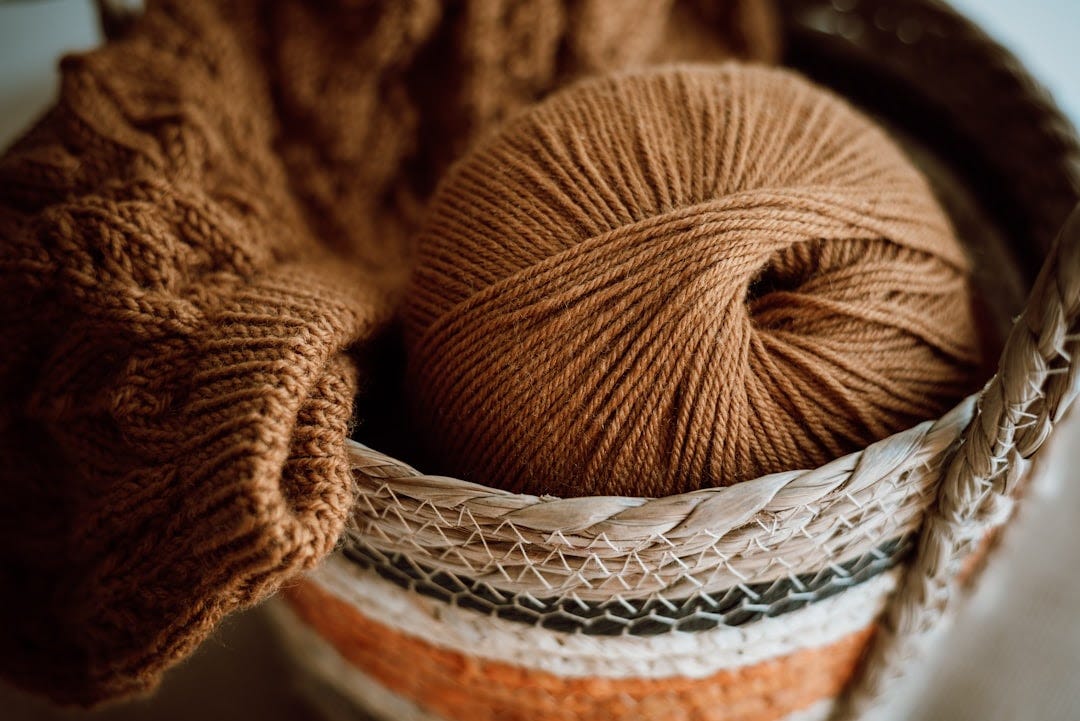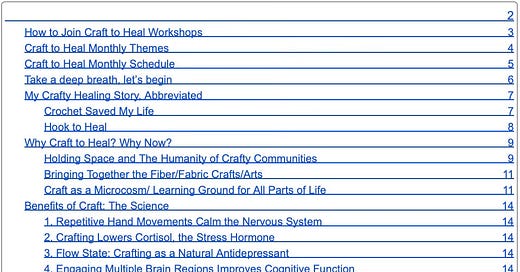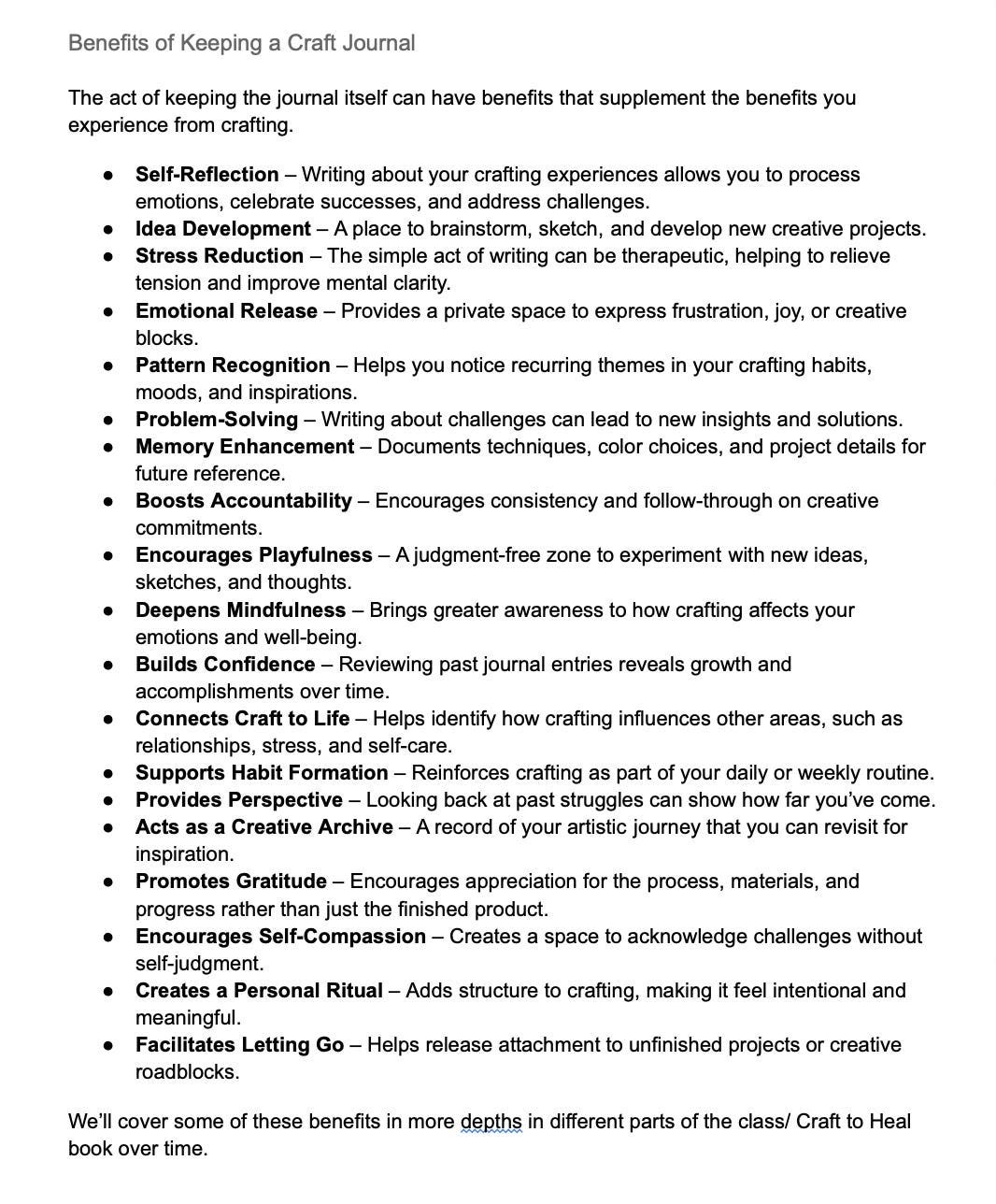Craft to Heal Chapter 1 Sneak Peek
How Engaging Multiple Brain Regions Improves Cognitive Function Through Fiber Arts, other benefits of crafting, and promo codes.
Craft to Heal is a yearlong content series for people who enjoy fiber / fabric crafts and want to practice amplifying their benefits to heal, grow, and connect to self and community.
It consists of monthly PDFs of material that will eventually become the new book of the same name.
But I thought everyone might want to see just a little bit of what I’m offering. It’s not too late to sign up to join Craft to Heal! And I’ve got some discount codes for you:
Sneak Peek of The First Craft to Heal PDF!
Everyone who attended the very first session, as well as my paying subscribers, received access to a 30-page PDF. Here’s what the Table of Contents looks like for that:
Here are a few excerpts from different sections to give you a sense of what is in those pages.
Bringing Together the Fiber/Fabric Crafts/Arts
Craft to Heal is based on Hook to Heal but I’ve put/ am putting time and energy and research and curiosity into making each of the exercises adaptable to all of the thread and yarn, fiber and fabric crafts. Most of the benefits I know are true of crochet are also naturally true of knitting, sewing, embroidery, quilting, needle felting, punch needling, weaving … and so forth.
Many of the benefits extend to other crafts. My dad was a woodworker and often shared parallels in his experience with my crochet experience.
I wanted to expand Hook to Heal into Craft to Heal because of this truth … and also because I think it’s a really critical time for us to come together as much as possible, instead of separating. For a long time, there was a distinction in the yarn world between knitters and crocheters … crocheters made granny squares and doilies and knitters made sweaters and the two groups often looked down upon each other which you might have experienced if you were a crocheter who went to shop at a local yarn store a couple decades ago.
There also used to be a big separation between right-handed and left-handed crafters. Almost all instruction that was available was for right-handed people and they were expected to adapt and if they couldn’t then they weren’t going to learn.
And I’m not even going to get into the distinction of “craft” vs “art” because that’s a whole big conversation that could use a book of its own. And although I’ve written about it elsewhere and would like to do so in more depth eventually, I’m not going to elaborate here on all of the exclusion and privilege in various craft groups, especially in craft as activism, that mirror divisions in gender, race, and all the isms.
The point is that even within the seemingly simple, friendly, low-stakes world of crafting, we have had a whole lot of divisions over the years. We can divide and divide ourselves into ever smaller groups.
OR!
We can intentionally bring ourselves together into one group. So Craft to Heal is my way of starting small to bring together all of the different fiber crafters/artists who want to utilize their craft to heal, grow and connect, into one space, one discussion, one community.

Engaging Multiple Brain Regions Improves Cognitive Function
Crafting isn’t just soothing—it actively strengthens the brain. Studies have found that fiber arts engage multiple areas of the brain at once:
The prefrontal cortex, responsible for problem-solving and decision-making
The hippocampus, which supports memory and learning
The sensorimotor cortex, which controls fine motor skills and coordination
This multi-regional brain activation has been shown to reduce the risk of cognitive decline. Research suggests that engaging in creative activities like knitting, quilting, and embroidery may reduce the likelihood of developing dementia by up to 50%. (There are a lot of factors in age-related memory loss, including many we don’t know yet, and this can vary a lot from person to person, but studies often cite this number.)
Crafting Without Judgment Exercise
Why it matters: Perfectionism and self-criticism often sneak into creativity. This exercise helps release expectations and enjoy the process.
Choose a small project or grab some scrap fabric, yarn, or thread—something you’re not emotionally attached to.
Set a 5-minute timer and allow yourself to create freely—stitch, crochet, knit, or quilt without a plan.
If you make a “mistake,” embrace it. Try turning it into something new.
Notice any thoughts of judgment or hesitation that come up. Gently remind yourself: This is play. There is no wrong way to do this.
When the timer ends, reflect: How did it feel to create without expectation?
Want to receive entire PDFs like this every month for a year?





